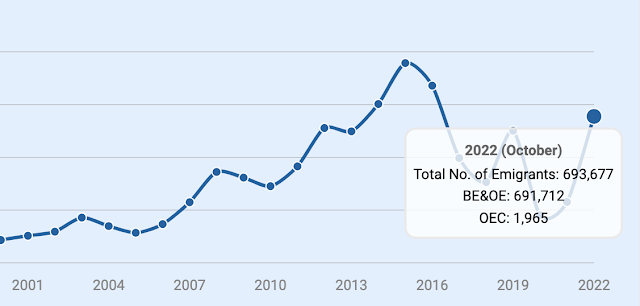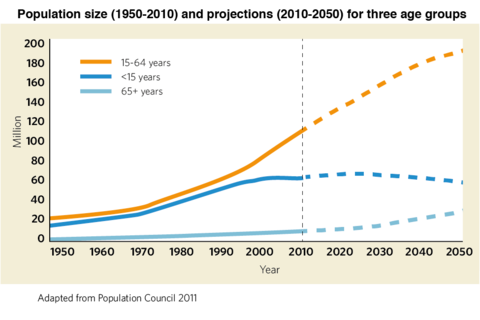PakAlumni Worldwide: The Global Social Network
The Global Social Network
World at 8 Billion: Pakistan is Fourth Largest Contributor to Last Billion
The global population increased by one billion over the last 12 years to reach 8 billion this year, according to the United Nations. Pakistan contributed 49 million people to the last billion, making it the fourth largest contributor after India (177 million), China (73 million) and Nigeria (51 million). Nigeria is expected to soon overtake Indonesia and Pakistan to become the world's 4th most populous nation. More than half of the projected increase in the global population up to 2050 will be concentrated in eight countries: the Democratic Republic of the Congo, Egypt, Ethiopia, India, Nigeria, Pakistan, the Philippines and the United Republic of Tanzania. Rising working age population is turning Pakistan into a major global consumer market. It is also fueling Pakistan's growing surplus labor exports and record overseas worker remittances.
 |
|
|
 |
| World Population Visualization in 2022. Source: Visual Capitalist |
World's 7th Largest Consumer Market:
Pakistan's share of the working age population (15-64 years) is growing as the country's birth rate declines, a phenomenon called demographic dividend. With its rising population of this working age group, Pakistan is projected by the World Economic Forum to become the world's 7th largest consumer market by 2030. Nearly 60 million Pakistanis will join the consumer class (consumers spending more than $11 per day) to raise the country's consumer market rank from 15 to 7 by 2030. WEF forecasts the world's top 10 consumer markets of 2030 to be as follows: China, India, the United States, Indonesia, Russia, Brazil, Pakistan, Japan, Egypt and Mexico. Global investors chasing bigger returns will almost certainly shift more of their attention and money to the biggest movers among the top 10 consumer markets, including Pakistan. Already, the year 2021 has been a banner year for investments in Pakistani technology startups.
 |
| Consumer Markets in 2030. Source: WEF |
 |
| World Population in 2050. Source: Visual Capitalist |
Labor Exports:
With rapidly aging populations and declining number of working age people in North America, Europe and East Asia, the demand for workers will increasingly be met by major labor exporting nations like Bangladesh, China, India, Mexico, Pakistan, Russia and Vietnam. Among these nations, Pakistan is the only major labor exporting country where the working age population is still rising.
 |
| Working Age Population Declining Among Major Labor Exporters. Sourc... |
Over 10 million Pakistanis are currently working/living overseas, according to the Bureau of Emigration. Before the COVID19 pandemic hit in 2020, more than 600,000 Pakistanis left the country to work overseas in 2019. Nearly 700,000 Pakistanis have already migrated in this calendar year as of October, 2022. The average yearly outflow of Pakistani workers to OECD countries (mainly UK and US) and the Middle East was over half a million in the last decade.
 |
| Pakistani Workers Going Overseas. Source: Bureau of Emigration |
Haq's Musings
South Asia Investor Review
Pakistan is the 7th Largest Source of Migrants in OECD Nations
Pakistani-Americans: Young, Well-educated and Prosperous
Last Decade Saw 16.5 Million Pakistanis Migrate Overseas
Pakistan Remittance Soar 30X Since Year 2000
Pakistan's Growing Human Capital
Two Million Pakistanis Entering Job Market Every Year
Pakistan Projected to Be 7th Largest Consumer Market By 2030
Hindu Population Growth Rate in Pakistan
Do South Asian Slums Offer Hope?
-
Comment by Riaz Haq on January 22, 2023 at 7:29pm
-
During the year 2022 (December), 832,339 Pakistanis proceeded abroad for the purpose of employment.
https://beoe.gov.pk/?__cf_chl_jschl_tk__=b1b4890b1c9705af3b244646c1...
Since inception of the Bureau in the year 1971, more than 10 million emigrants have been provided overseas employment duly registered with the Bureau of Emigration & Overseas Employment. During the year 2015, highest number of Pakistanis(946,571) proceeded abroad for the purpose of employment. During the year 2022 (December), 832,339 Pakistanis proceeded abroad for the purpose of employment.
-
Comment by Riaz Haq on March 16, 2023 at 4:54pm
-
Digital census process continues smoothly: PBS
https://www.pakistantoday.com.pk/2023/03/16/digital-census-process-...
ISLAMABAD: The process of the 7th Population and Housing Census, being conducting digitally for the first time in the country’s history, has been going on smoothly all across the country, the Pakistan Bureau of Statistics (PBS) reported here on Thursday.
“The overall progress and speed of the census process is very encouraging and satisfactory,” PBS said in a press statement issued here.
The process includes an option for self-enumeration, which was made available from February 20, 2023, till March 10, 2023, and field operations of house listing and enumeration commenced from March 01, 2023, that will continue till April 4, 2023.
Conducting a census digitally ensures transparency, data-driven procedures, real-time monitoring of progress through geo-tagging using GIS systems, and wider acceptability of census results, said PBS press statement.
It said structures were listed from March 1st to March 10, 2023, during which all the residential and economic units were geotagged along with the classification of economic activities as per international standards.
It said, the self-enumeration portal was very well received by people who have enumerated themselves using the portal launched and this method was optional.
Currently, the final phase of the census i.e. enumeration is ongoing starting from March 12, 2023, and would continue till April 4, 2023. In this phase, the data about household members and their demographic characteristics, various Socio-Economic Indicators, as well as Housing characteristics, are being collected.
PBS technical team is analyzing and assessing the data and trends on a day-to-day basis to ensure the quality of the data and progress in identified 291 blocks all over Pakistan. Physical verification and digital monitoring are being used for quality assurance.
PBS has established 495 Census Support Centers (CSC) at the Census District level and 495 Census Support Centers (CSC) at the tehsil level where over 1,095 IT experts of NADRA and PBS team are available 24/7 for technical assistance and facilitation of field staff.
The control room has been established at the CSC level which facilitates census field staff during field operation and for this purpose, NADRA technical teams are available to redress all IT-related issues.
A call center is operating 24/7 for facilitation, assistance and suggestions through the toll-free number 0800-57574.
It said, certain quarters were spreading false and misinformation, adding information shared on the PBS website and official social media should be believed and considered.
-
Comment by Riaz Haq on March 17, 2023 at 4:49pm
-
Why are women in #China not having more babies despite gov't incentives? With rapidly #aging and declining #population and slowing #economic growth, China’s leaders are asking #women to have three children again, but it's too late. #economy #fertility https://www.marketplace.org/2023/03/17/why-are-women-in-china-not-h...
Fewer people might mean slower growth in China, which will be felt by the U.S. and beyond.
“They’ve now become, you know, the center of the global manufacturing superhighway and are typically the largest contributor to growth every year,” said Scott Kennedy with the Center for Strategic and International Studies in Washington D.C.
Chinese officials often credit the so-called one-child policy for preventing over 400 million births, but some analysts say China’s population would have declined regardless.
“It’s just simply a rule across all countries, that as you urbanize, and as you get a more educated female population that enters the workforce, fertility numbers fall,” Kennedy said.
-------
The number of Chinese workers is already declining; according to the World Bank, in 2001, China had 10 workers to support one retiree.
“In 2020, that was down to five working folks for each retiree and by 2050 it’ll be down to two,” Kennedy said.
He believes China still has time to offset the effects of population decline, including by boosting productivity, increasing the retirement age and lifting restrictions on people from rural areas to freely settle in cities with their families.
“I don’t think the problem has become so severe that demography is destiny, and China is destined to radically slow down and its chances of becoming an economic superpower breaking out of the middle income trap have been dashed,” Kennedy said.
“[But] these are pretty significant challenges.”
------
28-year-old Joy Yu’s parents each had three siblings. As they were growing up in the 1970s, the Chinese government started to limit the number of babies born.
Government statistics show on average a woman in China went from having about three babies in the late 1970s to just one.
Four decades on, China’s leaders are asking women to have three children again, which doesn’t sit well for Yu, an only child.
“For me to give birth to three children, my future husband must be rich enough to make sure I can live well without a job. This is a big challenge,” Yu said.
Last year, China’s population dropped for the first time in six decades by 850,000. That still leaves the country with 1.41 billion people but if the decline continues, there will be multiple impacts on the economy.
China began enforcing birth limits in the late 1970s when the country was poor and there were too many mouths to feed.
In a Chinese propaganda film called the Disturbance of Gan Quan Village, the birth restrictions were justified on economic grounds.
“We should put our energy into getting rich rather than keep having children,” says one woman in the film.
She’s sitting among a group of women picking corn kernels off the cob. “Aren’t we getting poorer with each child we have,” she says. The rest of the group nods in agreement.
Chinese leaders enforced, sometimes brutally, the so-called one-child policy in 1979, just as the country was coming out of the tumultuous Cultural Revolution.
“The post-[Chairman] Mao leadership thought that economic development would be the new basis for the party’s political legitimacy and based on pseudo-scientific and demographic projections, limiting birth to one child per married heterosexual couple,” said Yun Zhou, an assistant professor of sociology at the University of Michigan.
There were exceptions. Some ethnic minority groups could have up to three children. People from rural areas could try for a second child if their first-born was not a boy. Later, if both parents had no siblings they could have two children. Starting in 2016, China raised the birth limit for everyone to two children, but there was no sustained baby bump.
Comment
- ‹ Previous
- 1
- 2
- 3
- Next ›
Twitter Feed
Live Traffic Feed
Sponsored Links
South Asia Investor Review
Investor Information Blog
Haq's Musings
Riaz Haq's Current Affairs Blog
Please Bookmark This Page!
Blog Posts
Pakistan Gets its First AI Data Center
Data Vault and Telenor Pakistan have launched the nation's first dedicated AI data center in Karachi. It is designed to support startups, researchers, and government agencies with high-performance computing and GPU-as-a-service offerings. It is equipped with more than 3,000 Nvidia's highest performance H100 and H200 GPUs for which the Trump Administration issued export licenses. These GPUs cost from $40,000 to $60,000 each, making the Nvidia chips the biggest chunk of the investment…
ContinuePosted by Riaz Haq on December 10, 2025 at 11:00am
World Bank: Pakistan is 88% Urbanized
The World Bank researchers have recently concluded that 88 per cent live in urban areas. Their conclusion is based on satellite imagery and the Degree of Urbanization (DoU) methodology. The official Pakistani figures released by the Pakistan Bureau of Statistics (PBS) put the current level of urbanization at 39%. The source of this massive discrepancy is the government's reliance on administrative boundaries rather than population density and settlement patterns, according to the World Bank…
ContinuePosted by Riaz Haq on December 7, 2025 at 5:30pm
© 2025 Created by Riaz Haq.
Powered by
![]()


You need to be a member of PakAlumni Worldwide: The Global Social Network to add comments!
Join PakAlumni Worldwide: The Global Social Network